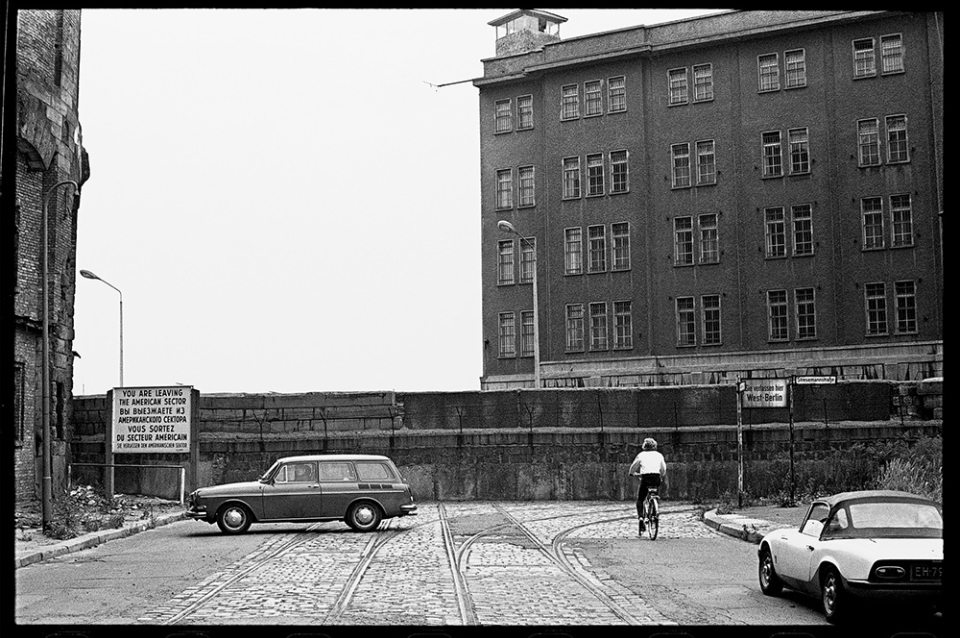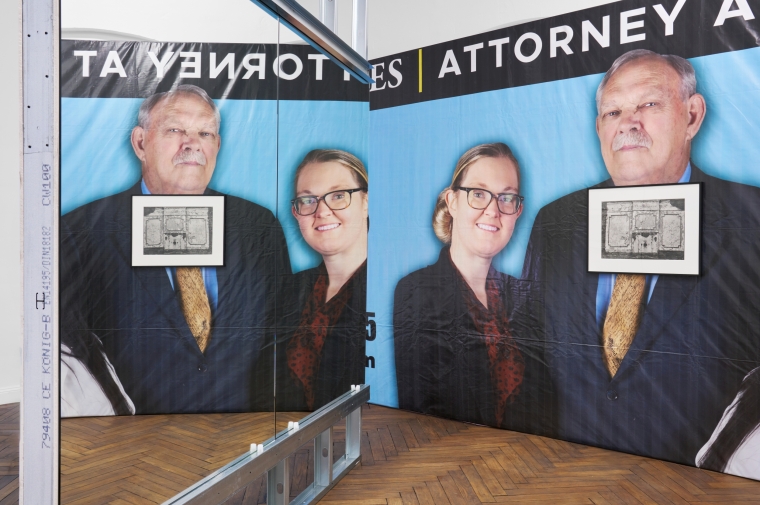March 13, 2020
Stuart Weitzman School of Design
102 Meyerson Hall
210 South 34th Street
Philadelphia, PA 19104
Get the latest Weitzman news in your Inbox
Media Contact
Michael Grant
mrgrant@design.upenn.edu
215.898.2539
In A Wall of Our Own: An American History of the Berlin Wall (University of North Carolina Press, 2020), Paul Farber, senior research scholar at the Center for Public Art and Space, traces the history of the Berlin Wall as a site of pilgrimage for American activists, writers, and artists. In this excerpt, Farber highlights the work of sculptor Shinkichi Tajiri, whose photographs documented the renovations and social realities of the Wall.
Excerpted from Chapter 3 | Scaling the Wall: Shinkichi Tajiri, Exiled Sculpture, and the Reconstruction of the Berlin Wall
At its center a violent, lethal non-place; an alluring, pitiless obstacle course; a forbidden zone with nothing but the silence before the shot. The actual designers were no longer in control of the architectural result of their work. . . . The Wall enjoyed a career as a thing of its own making.
—Olaf Briese
Within a decade of the initial construction of the Berlin Wall, the sprawling barricade aimed at keeping intact both the social vision and the citizenry of the German Democratic Republic, the ruling regime eyed improvements to its border system. The GDR intended to secure the permanence and elevate the esteem of the infamous structure. Sculptor Shinkichi Tajiri, a newcomer to West Berlin in 1969, was compelled by the Wall’s vast footprint and uneven surfaces under revision. The renovations of the late 1960s and early 1970s meant that the Wall, by design, would be in a state of constant change for several years. As the period of detente with the West unfolded, GDR officials tinkered with the massive overhaul of their byzantine border.
They ordered reconstruction of the wall system through a “robust mandate” to address the structural and aesthetic concerns over a border wall that had been hastily constructed, improvised even at its most significant and visible locations. Olaf Briese cites a 1965 internal document from the city command that stated, “The technical barriers are non-standard and maintenance intensive. . . . They often do not increase the prestige of the German Democratic Republic on the world stage.”(1) In addressing such concerns, the GDR aimed to remedy the function as well as the aesthetic reputation of a border wall that from its beginnings was as unwieldy as it was menacing, with built components placed clumsily in the interest of expediency. Briese explains that the East German regime carried out this first round of extensive revisions in the late 1960s and early 1970s, during which “the wall became the foremost element of a refined, graduated barrier system: an interior wall, a border alarm fence, antitank barricades, dog-patrolled areas (mainly on the edges of Berlin), observations towers, light arrays, patrol paths, plowed or raked strips of ground, trenches to prevent vehicular breakouts, and finally, at the outermost point, [a] strip of wall.”(2)
The revision’s most prominent feature, its outer western wall, consisted of a repeated sequence of prefabricated concrete horizontal slabs stacked into interlocked steel-supporting frames. The result was a wall that approached full standardization only after nearly a decade of existence.
From the perspective of Tajiri and others, the so-called wall was an amalgam of many intersecting structures of border control, on both sides of the divide. For Tajiri, an American expatriate of Japanese descent and veteran who had left his home country twenty years earlier, moving through divided Berlin brought him in contact with traces of U.S. military occupation. As he prepared to begin a teaching post at West Berlin’s Hochschule der Kunste, the border, in its state of partial construction, was too monumental to ignore.
At the time of his first trip to divided Berlin, Tajiri was already an internationally recognized sculptor and multimedia artist who incorporated a wide vocabulary of surrealist strategies into his work. Fashioning small models by hand, he made many of his large-scale sculptural works in his own foundry, located within a rehabilitated castle in which he and his family resided in the Netherlands. His works included intricate bronze fortresses and towers poured into carved brick molds, large metal war machines with giant legs and protruding weaponry, assemblages from metal drippings, and oversized hardened fiberglass and polyester knots. Many of his sculptures from this period constituted reflections on the relationship between violence, militarism, and technological advancement during the Cold War. As an artist in what he deemed a “self-imposed exile”from the United States, he viewed his country of origin from afar, with a posture of engaged and wary critique.(3)
In October 1969, Tajiri accepted an invitation to meet with officials about a guest professorship at the Hochschule der Kunste in West Berlin. He was summoned at the request of students who had seen his work at the prominent Documenta IV arts festival in Kassel, Germany, the year prior, at one of the international art world’s most prominent venues, and petitioned him to join the faculty. Tajiri accepted the position under unorthodox conditions: he would teach almost continuously for two weeks a month, live in a tent in his studio, and make himself readily available to students. The other two weeks, he would return to Baarlo and family and work on larger commissions. Tajiri’s own reasons for accepting this position in West Berlin had much to do with the tragic death of his wife, Ferdi, a Dutch artist and frequent collaborator, in a household accident in February 1969. A week before her death, the letter of invitation arrived from West Berlin but was ignored. Months later, when searching for his next steps, he rediscovered the letter. He decided to take intermittent time away from large sculptural works while mourning Ferdi and turn to the teaching position in West Berlin to support his family.
For his first meeting with administrators, Tajiri drove his speedy white Lotus Elan 2 from Baarlo to West Berlin. There he encountered the Wall and was immediately intrigued. He later recalled, “Once in the city center, I began to feel a low throbbing vibration, like a transformer plugged into the mains supply, but without a machine to relieve the current load. Driving towards the university, I was suddenly stopped by the Berlin Wall at the Brandenburg Gate. Walking along the Wall, it occurred to me that the vibration I had felt earlier might be energy that had been trapped within the city. . . . The air felt electric.”(4)
Between teaching spurts, this experience by the Wall beckoned him to embark on a new artistic undertaking. He set out to photograph the Wall in its entirety as a study in sculpture, focusing on the portion coursing through the middle of the city, from its southernmost point to its northern edge. Over a six-month period, he photographed in West Berlin after school or during his commute back to Baarlo, driving to a location, surveying the landscape, and shooting multiple frames. He eventually produced over 550 sequential negatives. While his goal was to grasp the sweeping, routine nature of the border wall system, he grappled with moments of variation, due in part to the Wall’s unwieldy path and his own desire to track particularly curious attributes or angles. In addition to viewing densely populated urban areas and checkpoints with border guards then familiar to global audiences, he located the Wall on the city’s margins: coursing through fields, cutting off access to bridges, jumping back and forth across waterways, and running into ruined buildings swallowed by the Wall’s path. In the artist’s view, the Wall constituted an evolving construction site and an embedded piece of architecture within a city steadily accustomed to its own division.
(1) Briese, “Different Aesthetics of the Berlin Wall,” 44.
(2) Ibid., 40.
(3) Tajiri, Autobiographical Notations, 45.
(4) Ibid., 69; Tajiri, Berlin Wall.
From A Wall of Our Own: An American History of the Berlin Wall by Paul M. Farber. Copyright © 2020 by the University of North Carolina Press. Used by permission of the publisher. www.uncpress.org


 Expand Image
Expand Image

